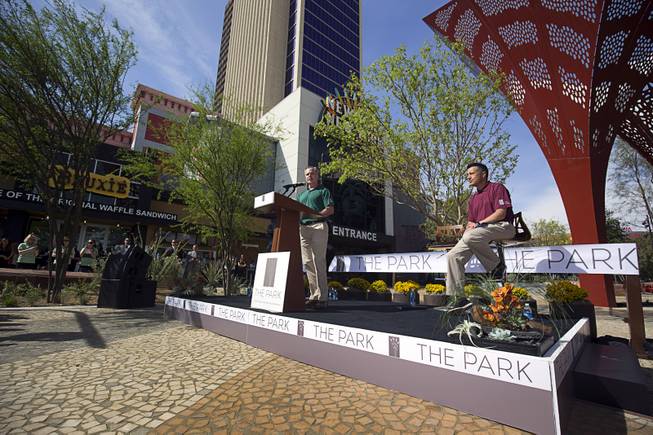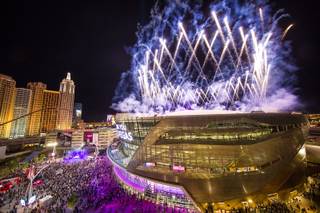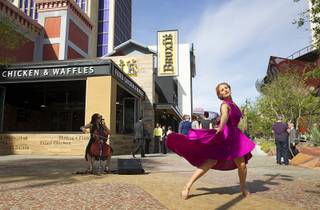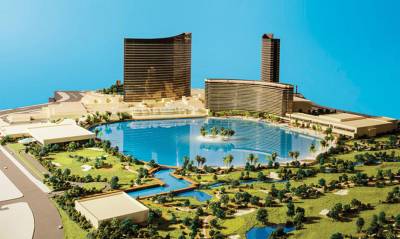
MGM Resorts International Chairman and CEO Jim Murren speaks during the grand opening of The Park on Monday, April 4, 2016. Gov. Brian Sandoval is seated at right.
Wednesday, April 20, 2016 | 2 a.m.
Jim Murren and Steve Wynn appear to have similar thoughts about where their Las Vegas customers increasingly want to spend time and money: on entertainment, on food and drinks and, whenever appropriate, in an outdoor environment.
The two casino moguls proved as much earlier this month, when Murren’s company debuted its 20,000-seat arena on the same day that Wynn announced plans for a new development behind his Strip resorts that would center around a 38-acre lagoon.
It’s no coincidence that neither of those projects include much — if any — gambling. As gambling revenue on the Strip continues to be eclipsed by non-gambling revenue, Murren’s MGM Resorts International and Wynn’s Wynn Resorts Ltd. have both indicated that their investments will follow suit.
MGM Resorts on April 4 opened its new dining and entertainment district, the Park, in between its New York-New York and Monte Carlo resorts. Two days later, the company opened the T-Mobile Arena, which it owns jointly with Anschutz Entertainment Group, in the same area.
The two projects go hand-in-hand. Visitors who enter the Park on foot from Las Vegas Boulevard stroll past water walls and through an open area filled with trees, art and a lineup of trendy restaurants on their way to the arena. There, they could see a number of big-name concerts and one day, if billionaire businessman Bill Foley is successful in convincing the National Hockey League to expand to Las Vegas, games played by the city's first major-sport pro team.
MGM Resorts is also currently building a 5,000-seat theater alongside the Park at Monte Carlo, which is expected to get a new name and a major revamp as it turns 20 this year.
Notably absent from any of the recent development activity from MGM Resorts: slot machines, table games or anything centered around a casino floor.
“As the state’s largest employer, its largest taxpayer, we needed to ensure that this legacy, this project, accomplished many goals,” Murren said in a speech at the opening of the Park. “First, we've got to make sure that we help Las Vegas to continue to evolve — to be that kind of place where people around the world need to go to see the new, the exciting, the very different.”
A similar effect could play out just a few miles north on the boulevard.
Wynn told investors on April 6 that he wanted to transform much of the golf course behind his Wynn Las Vegas and Encore resorts into a large lake surrounded by a white sand beach, plus a boardwalk, a 1,000-room hotel tower, meeting space, restaurants and more.
The project is tentatively titled Wynn Paradise Park, and it still needs approval from the Wynn Resorts board of directors in order to move forward. But if it comes to fruition, per the vision laid out by Wynn two weeks ago, customers would be able to water ski, paddle board and parasail during the day, while enjoying an elaborate, Disney-esque fireworks display at night.
“That golf course surrounded by all those meeting rooms and that water is once more a chance to reinvent Las Vegas. Period,” Wynn said in his presentation to investors. “Las Vegas has everything except beaches. It doesn't have an ocean. … So we decided to do it.”
Paradise Park customers would pay an admission fee, apparently in the $25 to $30 range, as suggested in Wynn’s comments earlier this month. A Wynn Resorts spokesman said the fee would not apply to hotel guests.
While the company has said that Paradise Park would include a “small casino,” gambling is not a major focus of the project. Wynn made that clear during the investor presentation, when he spoke repeatedly about the importance of non-gambling revenue.
“There will always be that 40-odd million people here. And what I am saying is I want to give them something to do,” he said, referring to Las Vegas’ annual visitor volume. “I don't give a damn if they put a nickel in a slot machine. I want them to pay my admission. I want them to stay in my rooms. I want them to drink my booze and eat our food.”
Still, if Wynn’s history is any indication, Paradise Park could be a game-changer for the Strip.
“Anytime Steve Wynn is going to put two bricks together in Vegas, I think it’s huge news,” said David Schwartz, director of the UNLV Center for Gaming Research. “It’s because of his track record ... going back to the Golden Nugget downtown, where he raised the bar downtown, to the Mirage, where he changed the way that casinos are built and operated on the Strip, to Bellagio and Wynn, where he amplified those changes. I think anything he does is going to be really interesting.”
Paradise Park isn’t the only big development Wynn has planned for Las Vegas: He’s already developing a new retail facility, Wynn Plaza, on his property near Las Vegas Boulevard. That will add some 75,500 square feet of luxury retail space to Wynn and Encore, and it’s expected to open in the fall of next year.
Paradise Park, MGM’s T-Mobile Arena and the Park are also all in good company in terms of casino operators focusing on non-gaming development. Caesars Entertainment Corp. opened the Linq promenade and High Roller observation wheel between its Flamingo and Linq (formerly Quad) resorts in 2014, and the open-air Grand Bazaar Shops opened in front of its Bally’s resort in 2015. Also, Las Vegas Sands Corp. recently proposed building a 65,000-seat domed football stadium on land owned by UNLV near McCarran International Airport.
Schwartz said the projects were connected by a common factor: the generally diminished role of gaming revenue compared to nongaming revenue on the Strip. With tourists spending so much more of their money away from tables and slots, Schwartz said it was understandable that development would literally shift away from the casino floor.
While the Strip’s gaming revenue fell 2.5 percent in the 2015 fiscal year, total revenue actually grew 2.7 percent, according to the Nevada Gaming Control Board. And the Las Vegas Convention and Visitors Authority’s latest visitor profile showed that only 73 percent of tourists said they gambled while they were in town last year, compared to 77 percent four years earlier.
“It’s not like it was in the old days, where everything was supporting the casino,” he said. “Now everything else is the profit center — in addition to the casino being a profit center.”




Join the Discussion:
Check this out for a full explanation of our conversion to the LiveFyre commenting system and instructions on how to sign up for an account.
Full comments policy